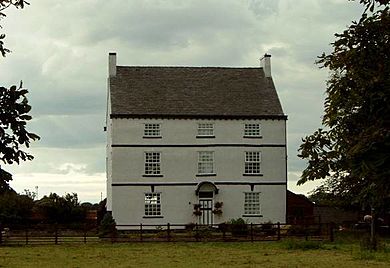John Byrom facts for kids
Quick facts for kids
John Byrom
|
|
|---|---|

Portrait of Byrom as a young man
|
|
| Born | 29 February 1692 Manchester, England |
| Died | 26 September 1763 (aged 71) Manchester, England |
| Occupation | Poet, inventor of a shorthand system, landowner |
| Nationality | English |
| Citizenship | British |
| Education | The King's School, Chester Merchant Taylors' School, Northwood Trinity College, Cambridge University of Montpellier |
| Alma mater | Trinity College, Cambridge |
| Notable works | Anglican hymn Christians Awake, salute the happy morn Poem My spirit longeth for Thee Coined the phrase Tweedledum and Tweedledee |
| Spouse | Elizabeth Byrom |
| Children | Dorothy Byrom, Edward Byrom |
John Byrom (born February 29, 1692 – died September 26, 1763) was an English poet and inventor. He created a special way of writing called shorthand. He also owned a lot of land.
Byrom is best known for writing the words to the famous Christmas hymn "Christians, awake, salute the happy morn". People say he wrote this song as a Christmas gift for his daughter.
Contents
John Byrom's Early Life
John Byrom came from an old, well-known family in Lancashire, England. His family had been successful wool merchants for many years.
Byrom was born in Manchester in 1692. Some people say he was born at a place called The Old Wellington Inn. Others believe he was born at Kersal Cell near Salford.
He was said to be one of the tallest men in England! Because his family was wealthy, John had a great education. He went to schools like The King's School, Chester and Merchant Taylors' School, Northwood.
He then studied at Trinity College, Cambridge. After that, he traveled to France and studied medicine at Montpellier.
Byrom's Shorthand System
John Byrom invented a special way of writing called shorthand. This system lets you write very quickly using symbols instead of full words. He made his system perfect after returning to England in 1716.
People in Manchester wanted him to be a doctor, but John felt he wasn't good enough at medicine. So, he decided to teach his shorthand system instead. In 1740, he got a special patent for his "New Universal Shorthand."
This shorthand system was so good that it was taught at famous universities like Oxford and Cambridge. Even the clerk of the House of Lords used it!
In 1742, a special law was passed to protect Byrom's invention. This law gave him the only right to publish his shorthand system for 21 years.
After he passed away, his shorthand system was published as The Universal English Shorthand. It was a very important step in the history of shorthand. Famous people like John Wesley and Charles Wesley, who started Methodism, used it to write their secret diaries.
John Byrom's Family Life
The Byrom family's old home was called Byrom Hall in Lowton. John lived there sometimes, but he mostly lived in a house in Manchester and at Kersal Cell.
John Byrom had three daughters and one son. His oldest child was his daughter Elizabeth, also called "Beppy." His son was named Edward. But his favorite child was his daughter Dorothy, who he called Dolly.
One day in December 1745, after playing with Dolly, John promised to write something special for her for Christmas. Dolly was so excited and reminded him every day as Christmas got closer.
On Christmas morning, Dolly found many presents. One envelope was from her father. It was the first thing she opened, and inside was a Christmas carol called "Christians, awake, salute the happy morn"! The original paper was even titled "Christmas Day for Dolly." This song was first printed in a newspaper in 1746.
Byrom's Other Writings
Even though he's famous for his Christmas carol, people during his time also thought of John Byrom as a great poet. Most of his poems, like My spirit longeth for Thee, were about religious topics.
He also wrote short, clever poems called epigrams. Byrom is also known for creating the funny phrase Tweedledum and Tweedledee. He used this phrase when talking about a friendly argument between two famous composers, George Frideric Handel and Giovanni Bononcini.
A Man of Mystery
John Byrom was not an ordinary person. He was a member of the Royal Society when Sir Isaac Newton was its president. This meant he knew many important scientists and thinkers in London.
Some modern researchers think he might have been a bit mysterious. For a long time, people thought he secretly supported the Jacobites (people who wanted a different king). But now, some believe he might have been a double agent, working for both sides.
He even wrote a clever poem about this:
- God bless the King! (I mean our faith's defender!)
- God bless! (No harm in blessing) the Pretender.
- But who Pretender is, and who is King,
- God bless us all! That's quite another thing!
John Byrom passed away in 1763. He is buried in his family's special chapel inside Manchester Cathedral in England. Sadly, many of his personal papers were lost or destroyed years after his death.
He was also a freemason, which is a member of a social and charitable organization. Some clues suggest he might have been part of a secret club that studied mysterious topics.
His wife lived until 1778. All of his property, including Kersal Cell, was left to his daughter Elizabeth. In 1870, many of his books and writings were given to Chetham's Library by his descendant, Eleanora Atherton.
Later, more of Byrom's papers were collected by the John Rylands Research Institute and Library. These papers help us learn more about his life and work.





